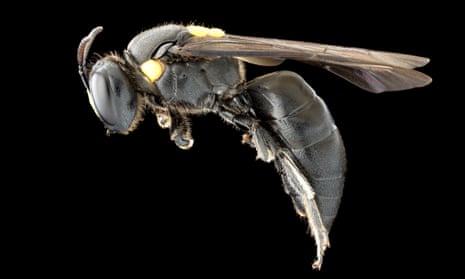The unusual social life of a native species of Australian bee has shed light on how cooperative behaviours in bees evolved, new research suggests.
Flinders University scientists have analysed the behaviour of Amphylaeus morosus, a forest-dwelling bee that lives in small nests of rarely more than two females.
The researchers believe the bee only made the switch from solitude to colony living relatively recently in its evolutionary history.
They found that in each nest, one single female laid all the eggs and foraged, while the other female – the sister or daughter of the first – guarded the nest and did not reproduce.
“When we think about bees, most people think about honeybees, [which have] highly complex social organisations with defined queen and worker roles,” said Lucas Hearn, a PhD student at Flinders University and the study’s first author. “Most bees are actually solitary.”
Australia is home to an estimated 2,000 native bee species. A. morosus is the only known social species in the Colletidae family – a family commonly known as plasterer or polyester bees.
“Because it’s the only social species, it has only recently evolved these social traits,” Hearn said.
“It can give us some really unique insights into how this initial transition from solitary lifestyle to living together in groups actually occurred.”

The way one of the bees in the colony never reproduces seemingly defies Darwin’s theory of natural selection, Hearn said.
“Darwin says that every individual should work for itself – should be selfish. But … you get these individuals not reproducing.”
However, the finding is in keeping with another evolutionary theory, Hamilton’s rule, which suggests that some females forgo reproduction if they are helping their kin – their related nest mates – to reproduce.
The native bee’s sociality was much more complex than initially thought, Hearn said.
“We were actually expecting equal reproduction.”
